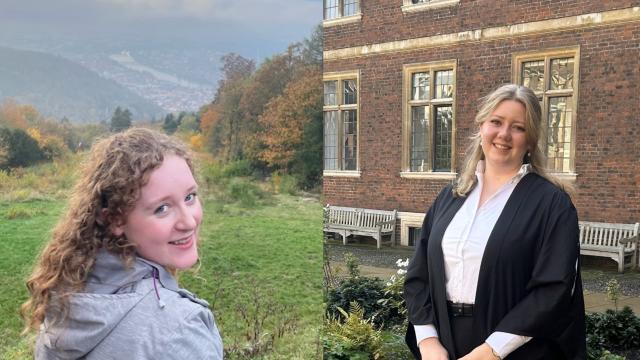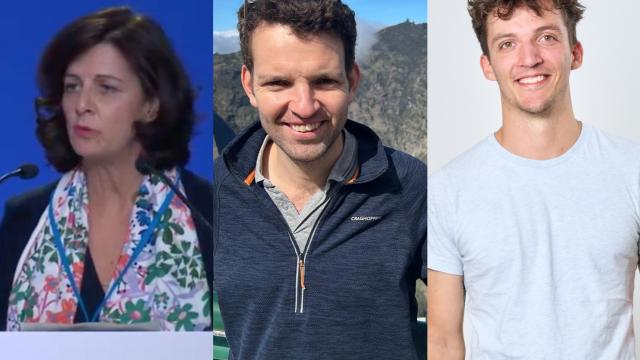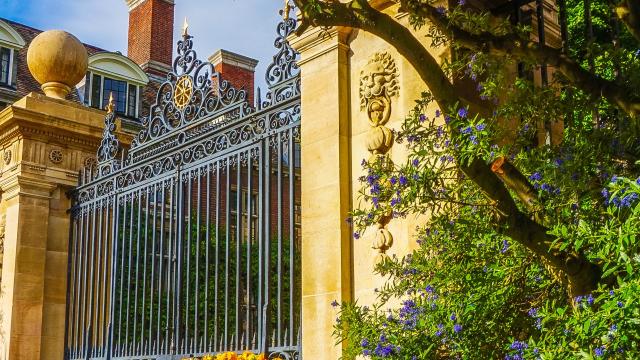
Unveiling of the portrait of Professor Sir Alan Battersby
Professor Ron Martin spoke as follows
Master, Fellows and College Guests
A very warm welcome to this reception to celebrate the unveiling of Alan Battersby’s portrait.
When Alan and I began to discuss the idea of having his portrait painted, we agreed immediately that there was only artist we wanted to undertake the commission, namely Paul Brason, whose outstanding portrait of our Master attracts universal acclaim by all who visit the Hall. We were delighted when Paul enthusiastically accepted the invitation, and I am also delighted that he is here tonight to share in our pleasure in seeing the skilful product of his labours. I think you will agree that the portrait is simply stunning.
Thinking about the unveiling tonight, I looked back at College archives and perused our excellent new College picture catalogue, to see when the College last commissioned a portrait of a Fellow, and to my surprise discovered that Alan’s is only the fourth such commission over the past fifty years. The first of the previous three was a pencil portrait of Alfred Steers, Emeritus Professor of Geography, undertaken in 1985 by the acclaimed artist Michael Noakes, and this small sketch hangs in my room. The other two were oils done in the early-2000s, one of Peter Boizot in 2002 and the other of Bevil Mabey in 2003, both Fellow Commoners. Each was painted by the same artist, Suresh Patel, and are – how I should put this? – rather idiosyncratic in style (both are ‘very big on hands’!). By comparison, Alan’s portrait, as we will shortly see, is in an utterly different league!
As Fellows will recall, in exactly three weeks time we will be celebrating Alan’s 90th birthday with a special Fellows’ dinner. I know this will be a memorable occasion indeed. But with his portrait, hanging here in the Long Gallery, we will also have a permanent record and reminder of one of the most distinguished of College Fellows: a scientist of world renown, a generous benefactor to the College, and, not least, a thoroughly companiable colleague!
And on that note, may I invite Alan to unveil the picture.

Alan replied as follows
Having now seen the portrait, painted by Paul Brason, I think you will agree that it is a wonderful one; Ron Martin said it was “stunning” and I fully agree with that. Many Fellows have asked me to say something about how the portrait evolved and also what happens during the painting.
Paul's studio is in Bath and initially he came to Cambridge for one day but later, during the actual painting, he stayed for two days. The first two visits were used to try all sorts of different ways I might sit or stand at different angles and in a variety of locations in the College and at my house. Each time Paul took lots of photographs; he must have taken well over 100 that he considered later in Bath. On the third visit, he said “Alan, I think I can now see what I want” and that is what you see here this evening. Then the actual painting started and it was done mainly in my house. Paul and I got on well from the outset and we became firm friends. So there was never any stress; sometimes we chatted and at other times we were silent; it was always comfortable. One minor problem was that I occasionally became very stiff in my right arm holding the chemical model and once it was cramp! Then we stopped, had a coffee and on return, I needed to get back to the exact position again directed by Paul using hand signals.
We both agreed early on that it would be good to have something in the portrait that connected to my scientific work and we wondered about using a molecular model of vitamin B12 but that would have filled the entire canvas. Many of you will remember the large molecular model of this vitamin that Peter Wothers had built in the Main Court a few years ago. I would have been looking through a huge collection of balls and sticks. So we decided to use this small molecular model you see at the bottom right of the portrait. For the chemists, this molecular model represents porphobilinogen and for the rest of the Fellowship, it shows the substance that is a very early starting material for the construction of vitamin B12 in the living systems. Interestingly this same small molecule is also the starting material from which haem of haemoglobin is built in our bodies and in addition, it is used to build chlorophyll in green plants. So you can see that it is a rather important substance and I spent over 30 years of my scientific career working on it and on all the far more complex materials built from it. Then Paul and I discussed having something set in the background related to one of my other interests. You all know that I have many such interests and we considered gardening, so possibly a spade - - No, then hiking in mountains, possibly boots - - No, and on through music and literature and so on until we reached fly fishing. This sounded perfect and you can see on the right a fly reel standing on top of one volume of the internationally famous book on trout. The chosen location was the OCR and there we can see the connection to the College with the Wheel.
So that is how the portrait evolved and I think you will agree that it is quite outstanding due to the meticulous care Paul gave to it. Not only does it accurately depict the physical presence of the sitter but it also catches the person inside. Thank you again Paul for producing this great portrait; I also want to record my warmest thanks to Peter Wothers and Ron Martin for enthusiastically carrying this project from the start through to this evening’s event. Finally, I am very happy that you have all come to share the unveiling with us; it has been a very special event for me. I am greatly touched that you, the Fellowship, wished to have this portrait painted and I thank you all.
90th Birthday celebrations
Professor Sir Alan Battersby’s speech at the dinner to celebrate his 90th birthday in March 2015
I am both delighted and touched that all of you, my friends in College, have come to Dinner this evening. It is a special occasion for me and I wondered what I should say to round off the evening. I look back to the 1920’s, almost pre-history to many of you, and it seemed appropriate to tell you about my early life; I hope you will enjoy the story. Certainly it is a surprising one, it is known by very few and it is right that for the first time it should be told at this gathering.
I was born in Leigh, a cotton and mining town about 15 miles from Manchester. My father was a small independent builder who worked just with one apprentice and he was able to give my mother 3 pounds each week. With this she managed to keep the family fed and healthy, indeed, she was a genius at financial management. I had a sister and a brother and we lived in a small semi-detached house at the end of a row of terraced housing. We had no electricity, no central heating just an open fire in the living room so the rooms on the upper floor of the house were very cold. I wore the clothing of the time so as a child, I wore little clogs that gave a pleasant clacking noise as I walked around.
Let’s move on rapidly to the age of 11 years when I took the 11 plus examination and fortunately passed to allow entry to Leigh Grammar School. It was a very good school, especially for mathematics, physics, chemistry and english. I enjoyed my school days and my examination results were good enough for entry into the Sixth Form. However, war broken out two years earlier and this greatly affected my thinking as you will hear.
First though, we need to get a feeling for the atmosphere of the time. I remember vividly Churchill's speeches; by then we had a radio that was in a wooden case with a fretwork front. The children were always gathered by our parents to hear these speeches and we listened, for example, to the famous one “We will fight on the beaches – ---- and so on ending “We will never surrender”. As we sat around the radio, a massive German army was gathering just across the Channel. Mother said to us “We may have a very hard time coming and there could be German soldiers fighting in our town. We must stick together and help each other.” I have told you this so you will realise that the war dominated all our thoughts.
We can now return to school and to the decision about entry to the Sixth form. No one in my family or in the extended family of aunts and uncles had been to university; it was a totally alien world to me. Also, there was a large war factory in my town where all sorts of electric cables for aircraft, warships, tanks and so on were manufactured. So I decided to leave school to work in this factory to help with the war effort and at the same time be able to add my wage to the small family finances. So that is what I did! The school was appalled but I stuck with it. I worked in the Control Laboratory at a weekly wage of 17 shillings and 6 pence, a little under 1 pound. Initially I quite enjoyed it but after three months, it was clear that all the interesting work was being done by graduates and all the boring routine tests for tin content, copper quality and sulphur determinations were being done by me, time after time. I was the dogsbody.
Yes, I had made a bad mistake and I needed to go to University but I only had the equivalent of O-levels. So I set up a correspondence course leading to the equivalent of A-levels at that time, the Higher School Certificate (H.S.C.). All my mathematics, physics and chemistry had to be learned by myself from textbooks guided by my unseen tutors. This study was done in the evenings after work and at the weekends. I also needed practical classes for physics and chemistry and for these I went by bus to Salford Technical College each Saturday. The northern blitz on Manchester and Liverpool was going on and sometimes the bus was late because of blockages of the road from the previous night’s bombing. I studied in this way for at least two years and could have been nearer three years but eventually I took the HSC examination and the results were amply good enough for University entrance.
So that was one of the hurdles overcome, the next was that my family could not possibly pay for me to study at a university. I had to win a scholarship and so I visited my former Headmaster at the Grammar School. Having admitted my mistake in leaving school, he was soon on my side and he checked his scholarship book saying that I should aim for a Lancashire Technological Scholarship that he said was a good one and would cover all the costs. Then his face fell on reading that the closing date was a month previously and the examination was the following Saturday. However he said he would telephone the Director of Education for Lancashire that day (he went straight to the top!) and would call in to our house on his way home to give me the result; we had no telephone. The outcome was that I was allowed to take the examination and fortunately I was successful. Those are two key men in my career; the Headmaster who was willing to do all he could to support me and the Director of Education who was willing to be flexible. Without them, I would probably not be standing with you today in St. Catharine's.
I was accepted by the University of Manchester to study chemistry, an excellent choice as the Chemistry Department was then one of the best in the country with Alex Todd as Professor of Organic Chemistry and Michael Polanyi as the Professor of Physical Chemistry. Todd later moved to Cambridge and I joined him there in 1969 to be eventually elected to the 1702 Chair, the one that Todd had held. Now there was a further complication because I was reaching the age for military call-up and I had already been called for medical examination for the Navy. However, by then the war was essentially won and would soon be over. Because it was clear at that point the country would need engineers, chemists and physicists, and mathematicians, for example, the Government decided to grant deferment to a number of students in these subjects provided they also undertook military training in the Officers Training Corps. There was no long vacation and the Degree was completed in two years and three months. Fortunately, I was given deferment and finally graduated from Manchester with First Class Honours in Chemistry.
From that point onwards, my career took a fairly conventional route in sharp contrast to what had gone before. The early part is not to be recommended at all but it did teach me some valuable lessons such as how to work intensively in a sustained way, how to study independently and the importance of a clear goal .
In conclusion, this has been for me and very special and heart warming event and I am most grateful to all of you for coming to make it so.



